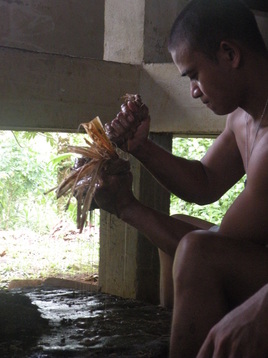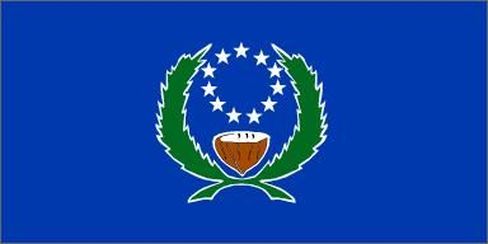
Squeezing Sakau in Hibiscus Bark
First of all, my apologies for the delay in this post. Like most people, things were busier than normal around the holidays. I promised at the end of my last post that my next entry I was going to take a break from writing about education and instead discuss something cultural. As I was looking for cultural topics to write about, it hit me again that I have become so accustomed to the culture here that it’s difficult for me to recognize how remarkably different this place is compared to America. I suspected that the holidays would present many new traditions and customs that I have not confronted yet. My suspicions were confirmed when attending several local Christmas parties.
A major part of Pohnpeian culture is sakau (pronounced sa-cow). Also known as kava, this drink used to be a ceremonial drink only available to the highest of the traditional leadership, but now is consumed by 70% of Pohnpeians, with many drinking it daily. It’s rare to go more than a mile without seeing the sign “Mie Sakau” (We have Sakau). The drink’s main effects are making the consumer very relaxed and tired, producing not exactly a “high” but more of a total-body lull. Subjectively, I believe the widespread drinking of sakau is not as bad as alcohol. Take for example how it affects driving capabilities. We all know that driving drunk can lead to disastrous consequences. Driving under the influence of sakau however is more funny than dangerous. The average speed of a sakau driver is 1-3mph. I have passed cars going this slow more times than I can count. As you can imagine, when a sakau driver crashes into a tree, he falls asleep, wakes up the next morning, and goes about his merry way.
This Christmas I had the chance to try sakau. Sakau is consumed across many islands in the Pacific, but is unique to each island. Therefore, you often hear about the preparation of “sakau en Pohnpei,” i.e. Pohnpeian sakau. It is prepared by crushing the roots of the kava plant. In almost every nas in Pohnpei (the traditional huts) there is a flat piece of basaltic stone for the preparation of sakau. The root is pounded with rounded river rocks then some water is added. The mushy root/water substance is then packed into the bark from a hibiscus tree. Consequently, it is twisted until the liquid substance is squeezed into a communal coconut cup when it is ready to drink. The substance is viscous, thanks to the hibiscus sap.
I was slightly concerned about trying sakau because I heard of a non-local having his tongue go numb for three months and having to talk with a lisp after drinking sakau. I wanted though to try it, at least to say I partook in a central element of Pohnpeian culture. I only took a large sip but it was unlike anything I have ever tasted. Immediately, I felt a numbing/tingling sensation on my lips. I was warned that many find the taste absolutely disgusting. It looks like muddy water, and kind of tastes like that as well, but I didn’t find it that dreadful. The numbing sensation lasted for about ten minutes. I never had a lisp though and wasn’t concerned the sensation would remain for long!
While I’m glad I had the chance to try sakau, I’m concerned over how dramatically it impacts the Pohnpeian people. I have read that it has no addictive properties, but many locals are obsessed with sakau and have to drink it every day. Whether that qualifies as an “addiction” is a matter of opinion. I have no hard evidence to support this, but I strongly suspect that the consistent consumption of sakau is disturbing normal brain functions. Those who drink it daily seem to function even slower than normal and overall the sakau culture is a large contributor to the general snail-like pace of all proceedings in Pohnpei. All that said, sakau is a major part of Pohnpeian life despite the diminished impact of traditional culture and will likely remain that way for years to come.
This weekend, I am looking forward to experiencing the Pohnpeian New Year. Apparently, things get pretty crazy – New Year is a big deal. So this year say “Parakup Mwao” (Pear-a-cup Mwow) – “Happy New Year” in Pohnpeian.
On the work side of things, I had the chance to tag along with John and meet Governor Ehsa (the Governor of Pohnpei) the week before Christmas to discuss our education project and learn more about opportunities for potential funding. We also have been busy writing grants to the Australian Embassy and developing our iPad program further. I’m looking forward to getting back in the schools next week and getting started with our program!
After talking with some relatives and friends back in the States I have been alerted that more pictures are necessary! Click here for a random collection of shots from November and December!
A major part of Pohnpeian culture is sakau (pronounced sa-cow). Also known as kava, this drink used to be a ceremonial drink only available to the highest of the traditional leadership, but now is consumed by 70% of Pohnpeians, with many drinking it daily. It’s rare to go more than a mile without seeing the sign “Mie Sakau” (We have Sakau). The drink’s main effects are making the consumer very relaxed and tired, producing not exactly a “high” but more of a total-body lull. Subjectively, I believe the widespread drinking of sakau is not as bad as alcohol. Take for example how it affects driving capabilities. We all know that driving drunk can lead to disastrous consequences. Driving under the influence of sakau however is more funny than dangerous. The average speed of a sakau driver is 1-3mph. I have passed cars going this slow more times than I can count. As you can imagine, when a sakau driver crashes into a tree, he falls asleep, wakes up the next morning, and goes about his merry way.
This Christmas I had the chance to try sakau. Sakau is consumed across many islands in the Pacific, but is unique to each island. Therefore, you often hear about the preparation of “sakau en Pohnpei,” i.e. Pohnpeian sakau. It is prepared by crushing the roots of the kava plant. In almost every nas in Pohnpei (the traditional huts) there is a flat piece of basaltic stone for the preparation of sakau. The root is pounded with rounded river rocks then some water is added. The mushy root/water substance is then packed into the bark from a hibiscus tree. Consequently, it is twisted until the liquid substance is squeezed into a communal coconut cup when it is ready to drink. The substance is viscous, thanks to the hibiscus sap.
I was slightly concerned about trying sakau because I heard of a non-local having his tongue go numb for three months and having to talk with a lisp after drinking sakau. I wanted though to try it, at least to say I partook in a central element of Pohnpeian culture. I only took a large sip but it was unlike anything I have ever tasted. Immediately, I felt a numbing/tingling sensation on my lips. I was warned that many find the taste absolutely disgusting. It looks like muddy water, and kind of tastes like that as well, but I didn’t find it that dreadful. The numbing sensation lasted for about ten minutes. I never had a lisp though and wasn’t concerned the sensation would remain for long!
While I’m glad I had the chance to try sakau, I’m concerned over how dramatically it impacts the Pohnpeian people. I have read that it has no addictive properties, but many locals are obsessed with sakau and have to drink it every day. Whether that qualifies as an “addiction” is a matter of opinion. I have no hard evidence to support this, but I strongly suspect that the consistent consumption of sakau is disturbing normal brain functions. Those who drink it daily seem to function even slower than normal and overall the sakau culture is a large contributor to the general snail-like pace of all proceedings in Pohnpei. All that said, sakau is a major part of Pohnpeian life despite the diminished impact of traditional culture and will likely remain that way for years to come.
This weekend, I am looking forward to experiencing the Pohnpeian New Year. Apparently, things get pretty crazy – New Year is a big deal. So this year say “Parakup Mwao” (Pear-a-cup Mwow) – “Happy New Year” in Pohnpeian.
On the work side of things, I had the chance to tag along with John and meet Governor Ehsa (the Governor of Pohnpei) the week before Christmas to discuss our education project and learn more about opportunities for potential funding. We also have been busy writing grants to the Australian Embassy and developing our iPad program further. I’m looking forward to getting back in the schools next week and getting started with our program!
After talking with some relatives and friends back in the States I have been alerted that more pictures are necessary! Click here for a random collection of shots from November and December!



